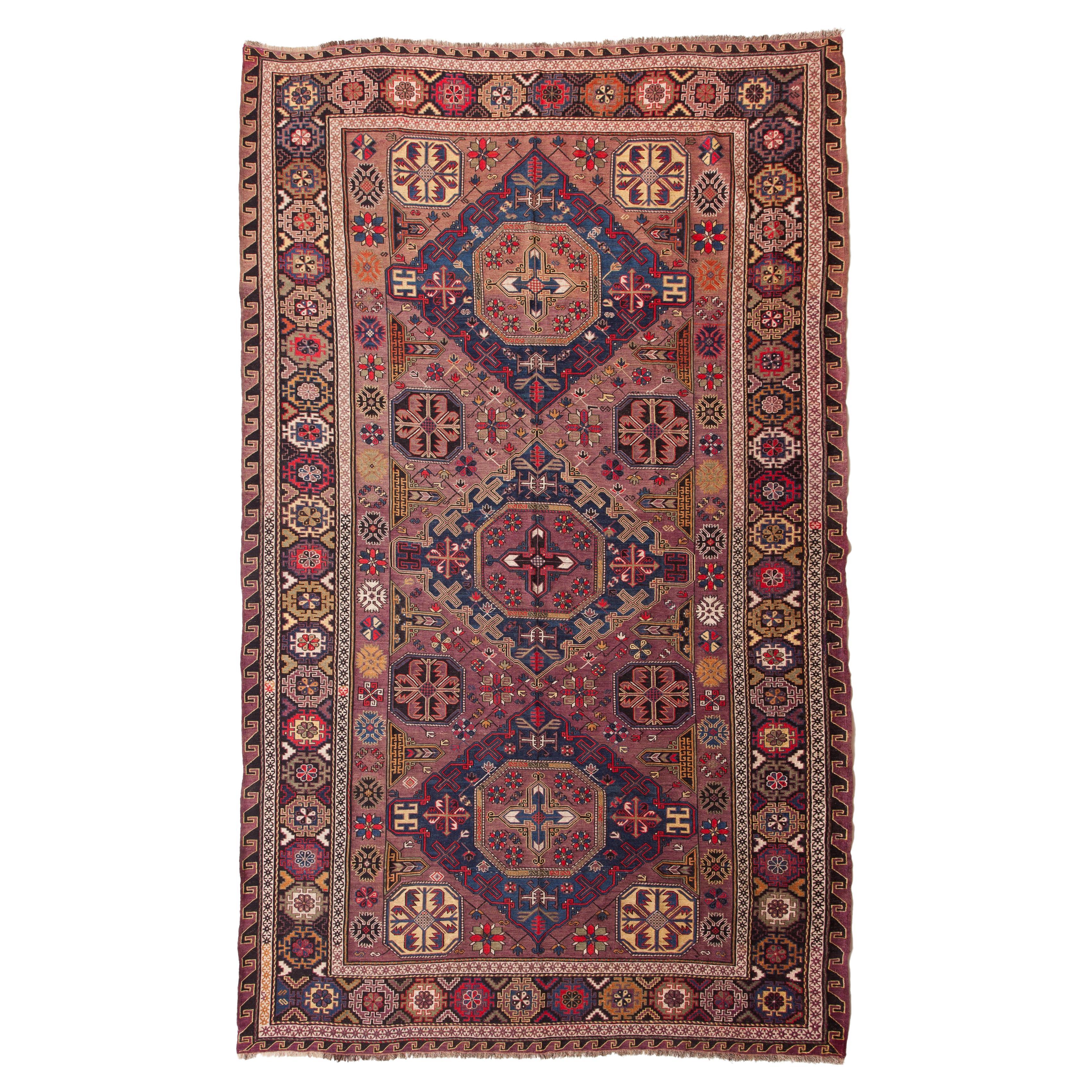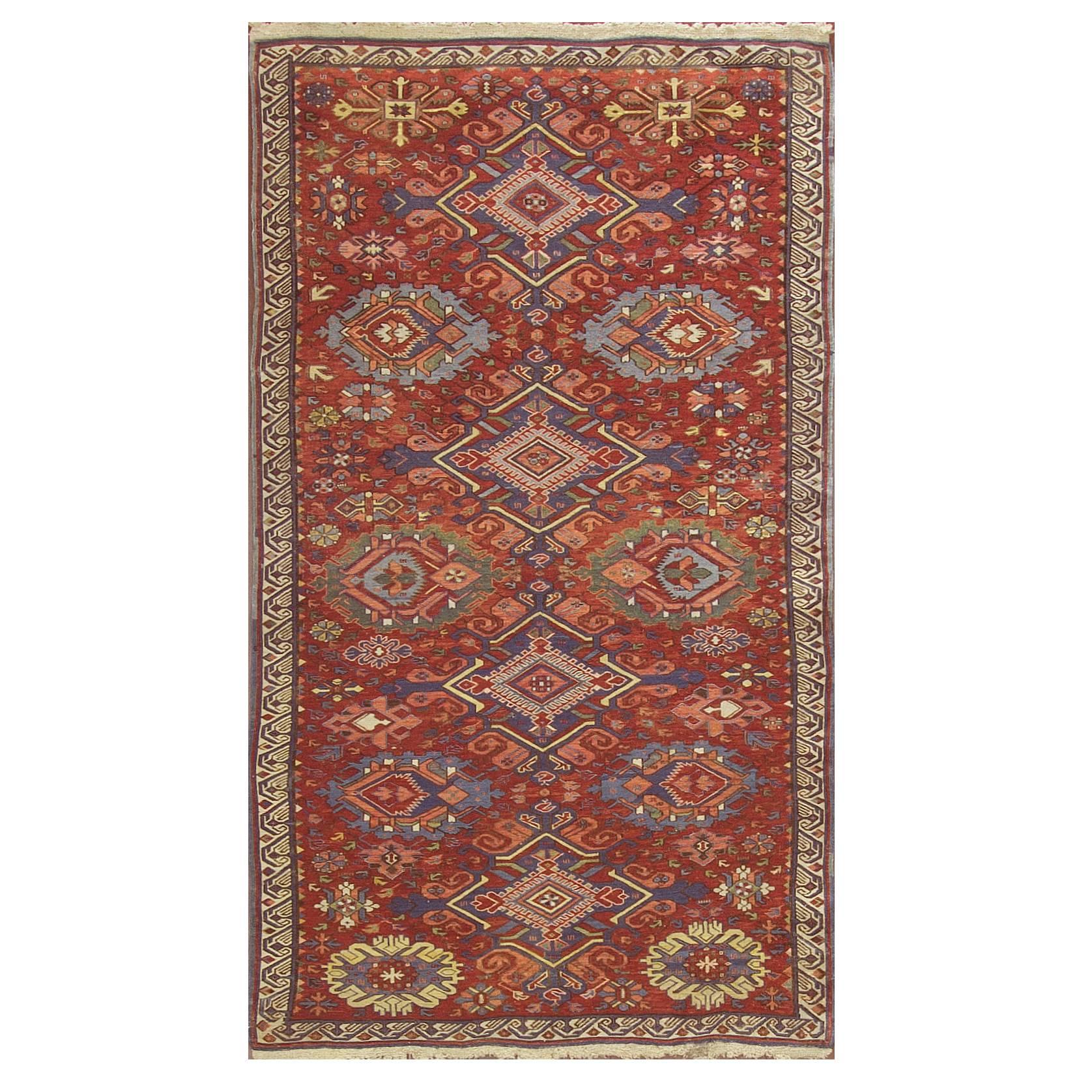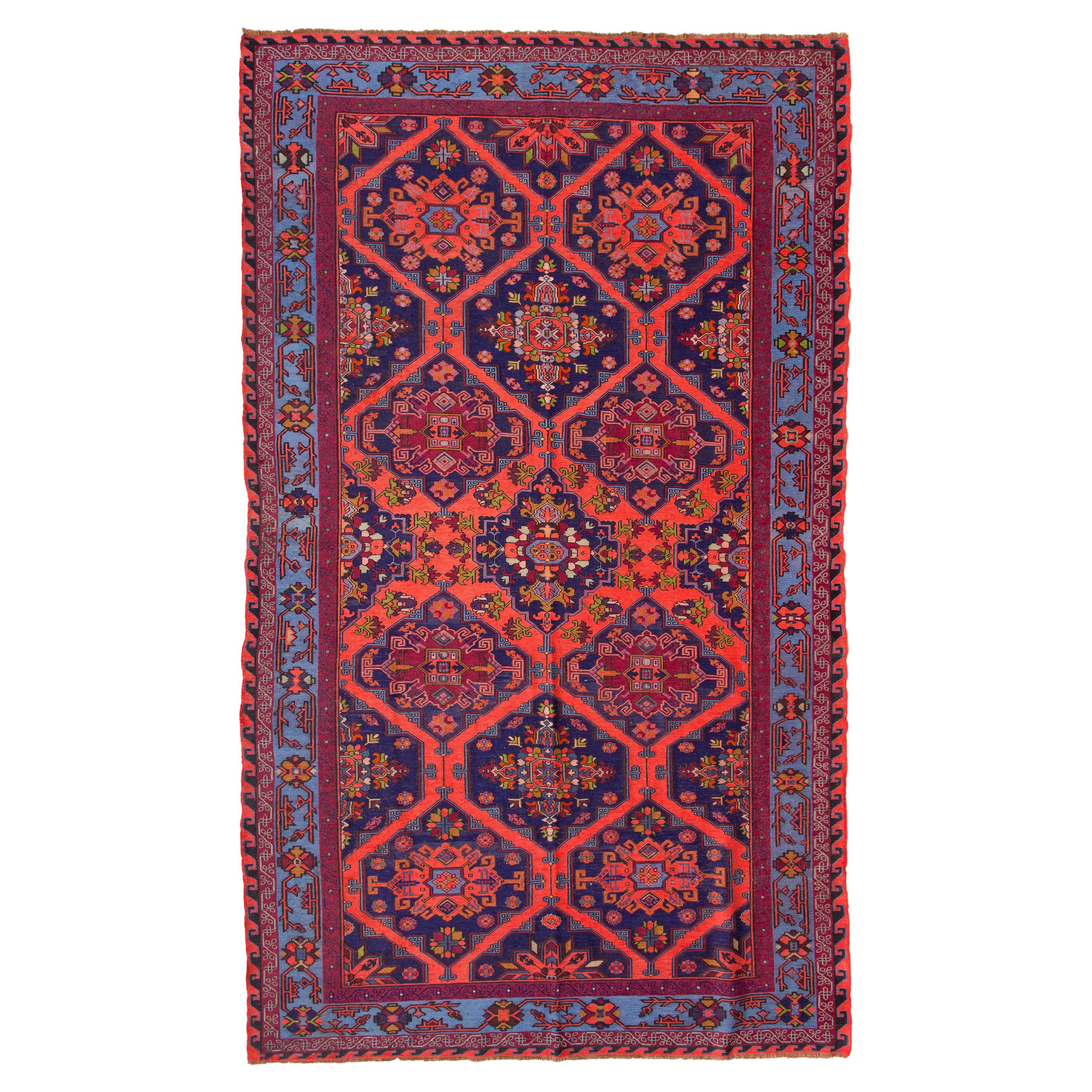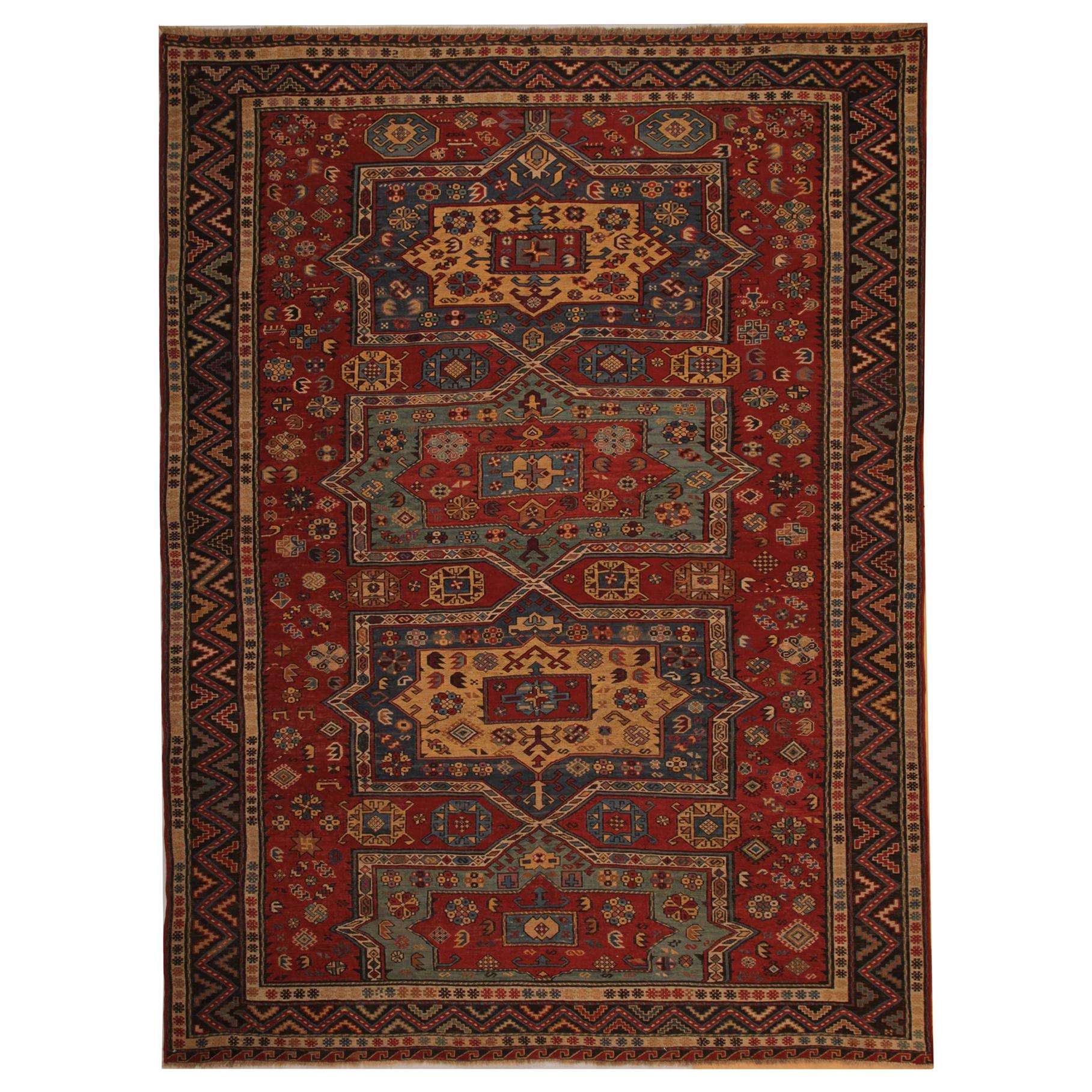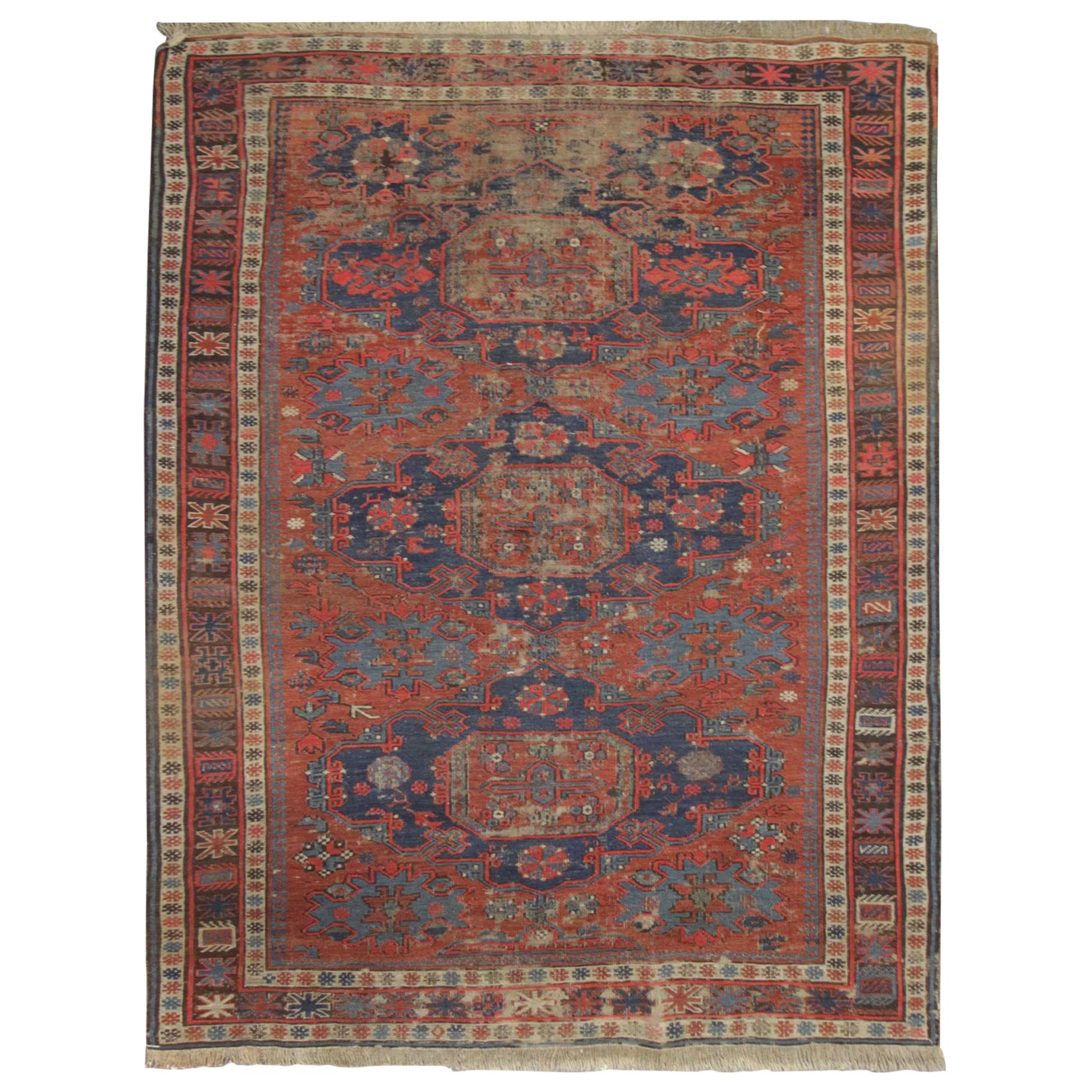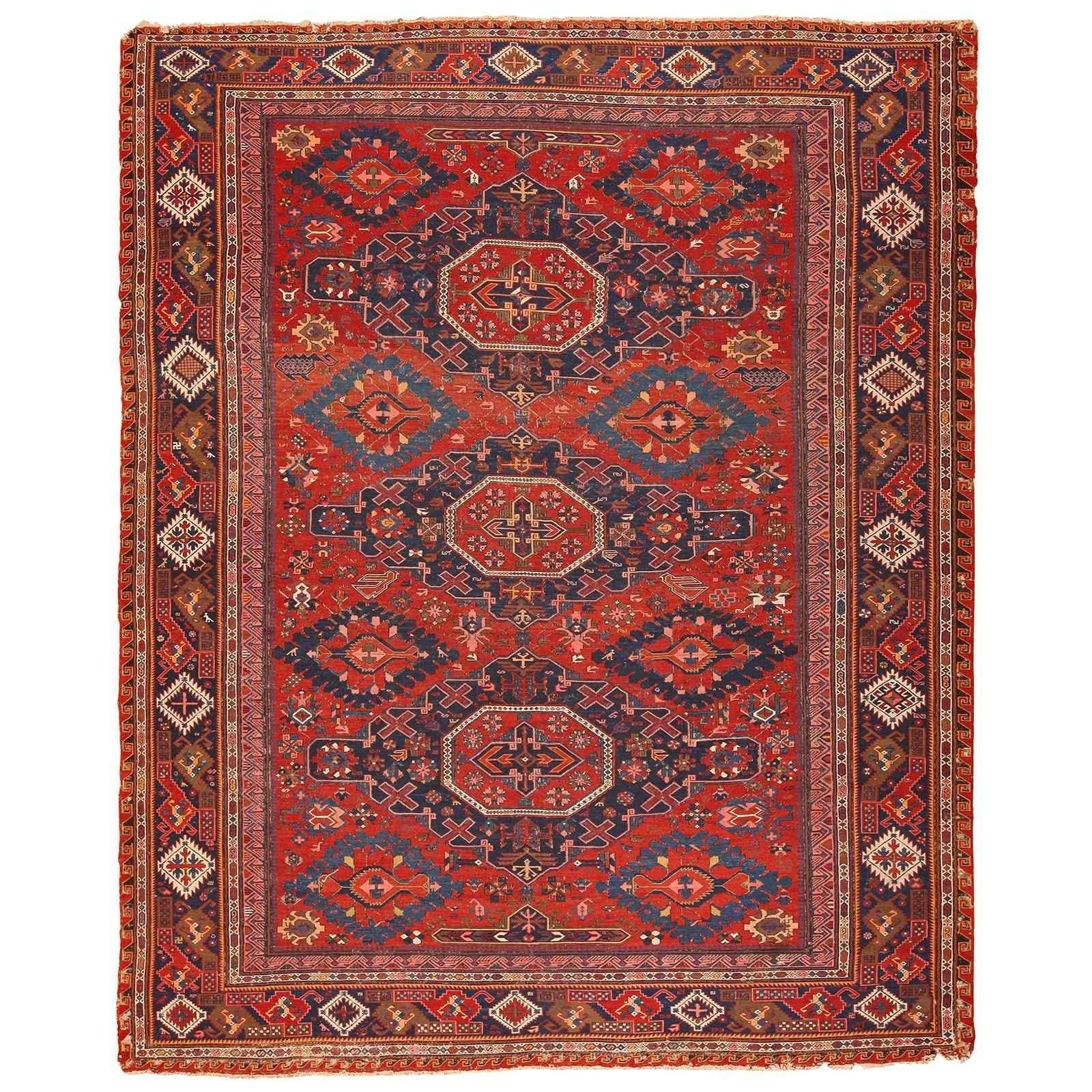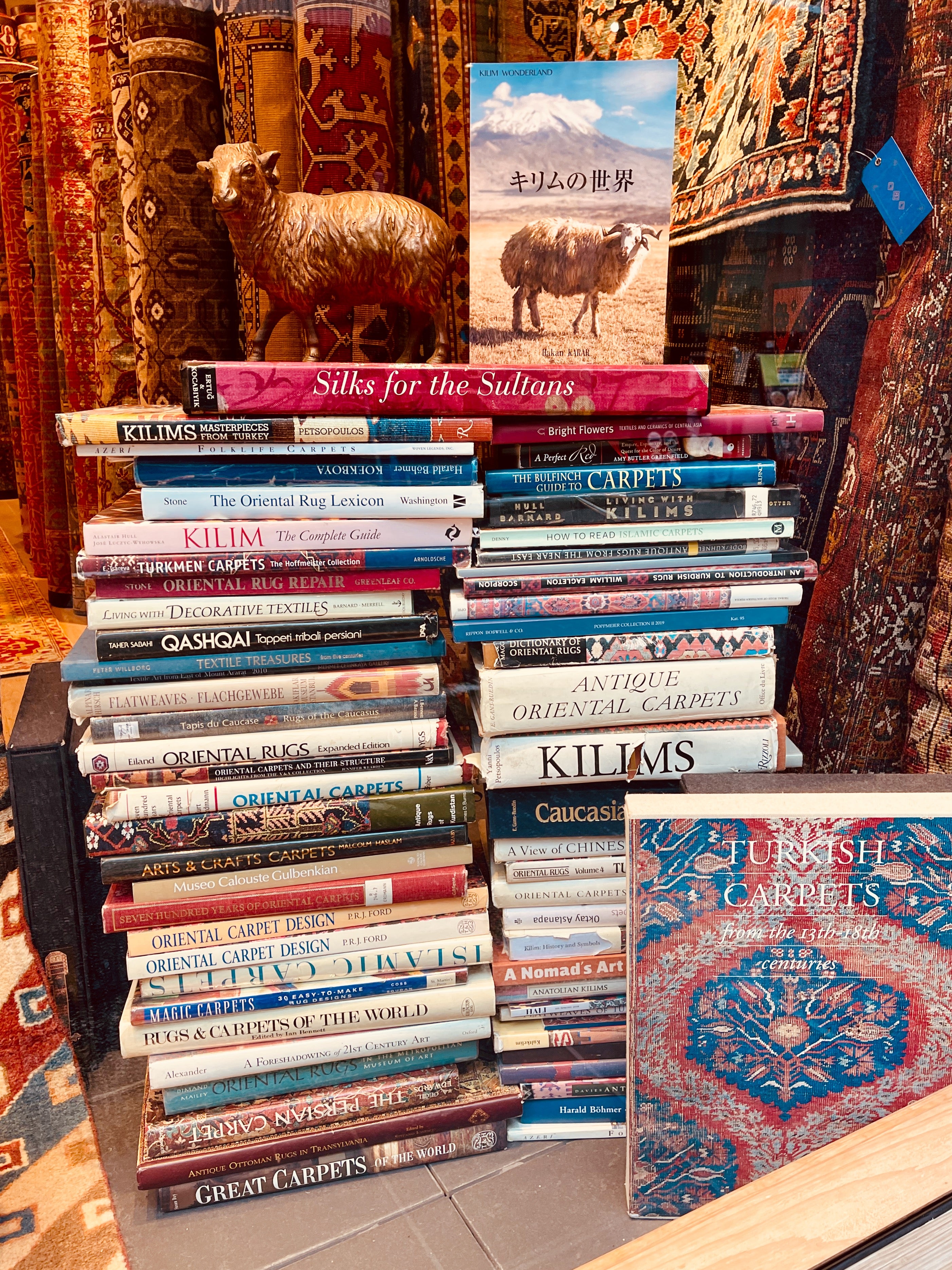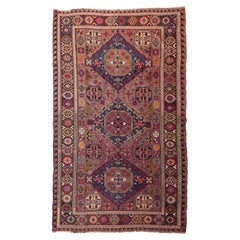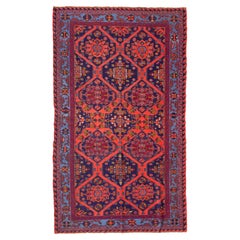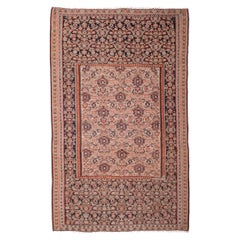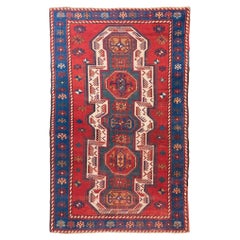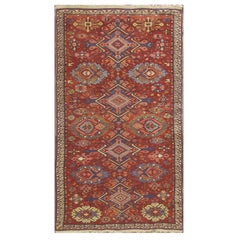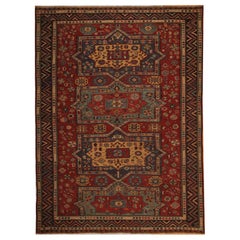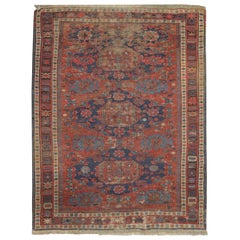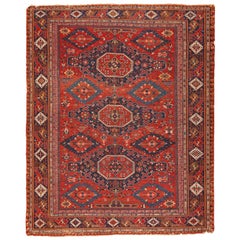Items Similar to Antique Caucasus Soumak Kilim Sumac Rug, Caucasian Sumak Natural Carpet
Video Loading
Want more images or videos?
Request additional images or videos from the seller
1 of 7
Antique Caucasus Soumak Kilim Sumac Rug, Caucasian Sumak Natural Carpet
$9,600
£7,328.25
€8,424.32
CA$13,508.92
A$15,022.48
CHF 7,890.13
MX$183,664.83
NOK 98,318.57
SEK 92,687.86
DKK 62,872.67
About the Item
This is an Antique Soumak ( Sumak, Sumac ) Kilim from the Caucasus region with a rare and beautiful color composition.
Of the four countries that make up the Caucasus, Azerbaijan produces the most kilims, and the land has a long history of weaving. The nomadic tribes wove kilims and carpets as well as a wide range of storage bags and sacks, such as saffrash, khurgin and chula, and donkey and horse trappings. Smaller bags for salt, utensils, and other items are also common. Not only are the Azerbaijani weavers prolific, but they also employ many techniques at the loom. These include slitweave- known locally by the word Kilim, warp-faced patterning (jajim), supplementary weft (zili), weft wrapping (popularly known as soumak), and extra weft wrapping (verneh). Furthermore, flatweaves are defined by regional names such as palas and shadda, so it is possible to ascribe a variety of weaving names to particular provenances as follows: soumaks are made in Kuba, palas, and kilims in Hajikabul, zili in Khizy, verneh and zili in Kazakh, shadda, verneh and zili in Barda, jajim in Agjabedi, and palas and kilims in Jabrail.
Soumak weave is a technique in which weft threads are added to a plain weave fabric, and one or two warp threads are wound from the front to the back. The resulting Kilim is denser and firmer, giving it a unique feel and look. This technique is commonly used in the Caucasus region.
Soumak kilims have a very beautiful contrast between orange that shines like the sun, deep purple-tinged indigo, and astringent dark red. You can also see the unevenly dyed abrage in this Soumak, which is like a magic carpet with an oriental atmosphere. Features of the Caucasian Kilim, such as the unique cosmic geometric floral pattern, are also found in this Soumak which has a bright look, but it also has a faded and textured feel, so it can be used in a good old atmosphere.
The woven fabric is particularly solid, so it is recommended for use in a solid living room or under a dining table without moving or twisting. A nice Kilim under a long wooden dining table.
- Dimensions:Width: 87.8 in (223 cm)Length: 108.27 in (275 cm)
- Style:Kilim (In the Style Of)
- Materials and Techniques:
- Place of Origin:
- Period:
- Date of Manufacture:circa 1880s
- Condition:Repaired: Minor repairs, with antique natural dyed wool threads by our repair specialists. Wear consistent with age and use. Minor losses. Minor structural damages. Minor fading.
- Seller Location:Tokyo, JP
- Reference Number:Seller: 270351stDibs: LU8206233380452
ARARAT RUGS
We know and believe that the geography we come from, our past, and our lifestyle are the most important bond between us to carry the oriental carpet art and culture to the next generations along with our core values in our ongoing growth journey.
We are aware that the way to achieve this goal and carry this priceless art and culture to the future depends on a lot of work with all our people every day while adhering to our core values.
For us, art is meaningful in the sense that it brings together various cultures around the world. It is an honor for us that oriental carpet art and culture have been instrumental in this for centuries and that we are a part of this business.
We are tirelessly keeping an eye on auction house information around the world about carpets. New York's Metropolitan, London's Victoria & Albert Museums, and other famous art museums, as well as small specialized museums that house private collections, and books about oriental carpets to collect information on outstanding carpet designs and patterns from around the world. It's our Self-improving and Self-developing culture.
As Turkish Culture of Hospitality, the Kurdish Culture of Generosity, and as Japanese Culture of Business Punctuality; are the most important values that this multicultural background has taught and bequeathed to us. It is essential and valuable for us that you feel this feeling not only by looking at our oriental carpets but from the moment you contact us.
About the Seller
5.0
Gold Seller
Premium sellers maintaining a 4.3+ rating and 24-hour response times
Established in 1970
1stDibs seller since 2023
57 sales on 1stDibs
Typical response time: 1 hour
- ShippingRetrieving quote...Shipping from: Tokyo, Japan
- Return Policy
Authenticity Guarantee
In the unlikely event there’s an issue with an item’s authenticity, contact us within 1 year for a full refund. DetailsMoney-Back Guarantee
If your item is not as described, is damaged in transit, or does not arrive, contact us within 7 days for a full refund. Details24-Hour Cancellation
You have a 24-hour grace period in which to reconsider your purchase, with no questions asked.Vetted Professional Sellers
Our world-class sellers must adhere to strict standards for service and quality, maintaining the integrity of our listings.Price-Match Guarantee
If you find that a seller listed the same item for a lower price elsewhere, we’ll match it.Trusted Global Delivery
Our best-in-class carrier network provides specialized shipping options worldwide, including custom delivery.More From This Seller
View AllAntique Caucasus Soumak Kilim Sumac Rug, Caucasian Natural Carpet
Located in Tokyo, JP
This is a large Antique Soumak ( Sumak, Sumac ) Kilim from the Caucasus region with a rare and beautiful color composition.
Of the four countries that make up the Caucasus, Azerbaijan produces the most kilims, and the land has a long history of weaving. The nomadic tribes wove kilims and carpets as well as a wide range of storage bags and sacks, such as saffrash, khurgin and chula, and donkey and horse trappings. Smaller bags for salt, utensils, and other items are also common. Not only are the Azerbaijani weavers prolific, but they also employ many techniques at the loom. These include slitweave- known locally by the word kilim, warp-faced patterning (jajim), supplementary weft (zili), weft wrapping (popularly known as soumak), and extra weft wrapping (verneh). Furthermore, flatweaves are defined by regional names such as palas and shadda, so it is possible to ascribe a variety of weaving names to particular provenances as follows: soumaks are made in Kuba, palas, and kilims in Hajikabul, zili in Khizy, verneh and zili in Kazakh, shadda, verneh and zili in Barda, jajim in Agjabedi, and palas and kilims in Jabrail.
Soumak weave is a technique in which new weft threads are added to a plain weave fabric, and one or two warp threads are wound from the front to the back. The resulting kilim is denser and firmer, giving it a unique feel and look. This technique is commonly used in the Caucasus region.
Soumak Kilims have a very beautiful contrast between orange that shines like the sun, deep purple-tinged indigo, and astringent dark red. You can also see the unevenly dyed abrage in this sumac, which is like a magic carpet with an oriental atmosphere.
Features of the Caucasian kilim, such as the unique cosmic geometric floral pattern, are also found in this Soumak. It has a bright look, but it also has a faded and textured feel, so it can be used in a good old atmosphere. The woven fabric is particularly solid, so it is recommended for use in a solid living room or under a dining table without moving or twisting. A nice kilim under a long wooden dining table.
Category
Early 20th Century Caucasian Kilim Caucasian Rugs
Materials
Wool, Natural Fiber
Old Caucasus Soumak Sumac Kilim Rug, Caucasian Natural Sumak Carpet
Located in Tokyo, JP
This is an old Soumak ( Sumak, Sumac ) Kilim from the Caucasus region with a rare and beautiful color composition.
Of the four countries that make up the Caucasus, Azerbaijan produces the most kilims, and the land has a long history of weaving. The nomadic tribes wove kilims and carpets as well as a wide range of storage bags and sacks, such as saffrash, khurgin and chula, and donkey and horse trappings. Smaller bags for salt, utensils, and other items are also common. Not only are the Azerbaijani weavers prolific, but they also employ many techniques at the loom. These include slitweave- known locally by the word kilim, warp-faced patterning (jajim), supplementary weft (zili), weft wrapping (popularly known as soumak), and extra weft wrapping (verneh). Furthermore, flatweaves are defined by regional names such as palas and shadda, so it is possible to ascribe a variety of weaving names to particular provenances as follows: soumaks are made in Kuba, palas, and kilims in Hajikabul, zili in Khizy, verneh and zili in Kazakh, shadda, verneh and zili in Barda, jajim in Agjabedi, and palas and kilims in Jabrail.
Soumak weave is a technique in which weft threads are added to a plain weave fabric, and one or two warp threads are wound from the front to the back. The resulting kilim is denser and firmer, giving it a unique feel and look. This technique is commonly used in the Caucasus region.
Soumak has a very beautiful contrast between orange that shines like the sun, deep purple-tinged indigo, and astringent dark red. You can also see the unevenly dyed abrage in this Soumak, which is like a magic carpet with an oriental atmosphere. Features of the Caucasian kilim, such as the unique cosmic geometric floral pattern, are also found in this Soumak which has a bright look, but it also has a faded and textured feel, so it can be used in a good old atmosphere.
The woven fabric is particularly solid, so it is recommended for use in a solid living room or under a dining table without moving or twisting. A nice kilim under a long wooden dining table.
Category
Mid-20th Century Caucasian Kilim Caucasian Rugs
Materials
Natural Fiber, Wool
Antique Senneh Kilim Senna Rug Wool Caucasia Sine Persian Kurdish Carpet
Located in Tokyo, JP
This is a Northwestern Persian Antique Kurdish Kilim from the Senneh ( Senna, Sanandaj) region with wool threads and a rare, beautiful color composition.
This highly collectible an...
Category
Early 20th Century Caucasian Kilim Turkish Rugs
Materials
Wool, Natural Fiber
Antique Sewan Kazak Rug Sevan Caucasian Carpet Late-19th Century Caucasus
Located in Tokyo, JP
This is a rare antique Sewan Kazak Rug from the Sewan / Sevan region in the southwest Caucasia.
This is another handsome example of the “Sewan” Ka...
Category
Antique Late 19th Century Caucasian Oushak Caucasian Rugs
Materials
Wool, Natural Fiber, Organic Material
Antique Erzurum Kilim Rug Old Eastern Anatolian Turkish Natural Carpet
Located in Tokyo, JP
This is an Eastern Anatolian Antique Kilim from the Erzurum region with a rare and beautiful color composition.
Erzurum was once a key frontier town, used to defend Anatolia against...
Category
Early 20th Century Turkish Kilim Turkish Rugs
Materials
Natural Fiber, Wool
Vintage Caucasian Kuba Super Fine Kilim Caucasus Old Rug Quba Traditional Carpet
Located in Tokyo, JP
This is a large, Caucasian Old Kilim from the Kuba region with a red background and beautiful color composition.
This Kilim is from Kuba, a city in Azerbaijan in the Caucasus regi...
Category
Mid-20th Century Caucasian Kilim Caucasian Rugs
Materials
Wool, Natural Fiber
You May Also Like
Antique Soumak Kilim Caucasian Rug
Located in Evanston, IL
Soumak rugs or Sumak, construction technique is flat-weave. They are strong and exceptionally durable. Unlike kilims, Soumak rugs are not reversible because non-clipped yarns are lef...
Category
Antique 1880s Caucasian Sumak Caucasian Rugs
Materials
Wool
Antique Rug, Caucasian Sumakh Kilim Rug, Flat-Weave Carpet Oriental Rug
Located in Wembley, GB
This handmade carpet Caucasian Kilim is defined is a Sumak: Caucasia is an area in the northwest of Azerbaijan Sumak refers to the weaving technique. This Kilim rug is completely handmade with the best wool and cotton. The dyes are organic. The Kilim reproduces a traditional design, the main colour is red.
Antique Caucasian handwoven Sumak rug. A very eclectic antique flat-weave rug from the Caucasus, woven in the intricate "Sumak" brocading technique, The Classic four-diamond medallion layout is rendered in a whimsical manner, with variations in the sizes and shapes of the medallions.
Antique Rug, Caucasian Sumakh...
Category
Antique 1880s Caucasian Kilim Caucasian Rugs
Materials
Wool, Cotton, Organic Material
Handmade Carpet Caucasian Sumakh Kilim Rug Oriental Traditional Wool Area Rug
Located in Wembley, GB
Featuring red and blue colorways in a geometric repeat central design which is enclosed by a triple layer highly detailed border. This high-quality area rug was hand knotted in the 1880s with hand-spun, vegetable-dyed wool and cotton, by some of the finest rug artisans. Perfect for any modern or traditional interiors, bedrooms, living rooms or even entryways, this rug is sure to uplift any room it is introduced to.
Handmade carpet Caucasian Sumakh Kilim rug...
Category
Antique 1880s Caucasian Tribal Caucasian Rugs
Materials
Wool, Cotton, Organic Material
$3,161 Sale Price
20% Off
Antique Caucasian Soumak Rug. Size: 9 ft 2 in x 11 ft 4 in
Located in New York, NY
Beautiful antique tribal Soumak rug, country of origin: Caucasus, date circa 1900. Size: 9 ft. 2 in x 11 ft. 4 in (2.79 m x 3.45 m).
This gorgeous tribal rug from the Caucasian mou...
Category
Early 20th Century Caucasian Tribal Caucasian Rugs
Materials
Wool
Rare Antique Caucasian Kilim Rug
Located in Wembley, GB
This handwoven antique Kilim was constructed in 1920 with fine hand-spun wool. The design features a double medallion in the centre and a detailed surround with smaller motifs and a ...
Category
20th Century Caucasian Tribal Central Asian Rugs
Materials
Wool, Cotton, Organic Material
$3,489 Sale Price
20% Off
660 - Antique Fine Senneh Kilim, 19th Century
Located in Paris, FR
660 - beautiful late 19th century Kilim Senneh with decorative design and pretty natural colors with blue, green, gray, red, pink, completely handwoven with wool on cotton foundation.
Category
Antique 1880s South Asian Kilim Central Asian Rugs
Materials
Wool
